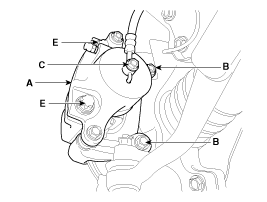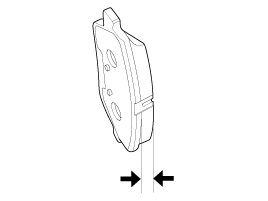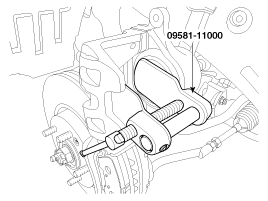Kia Optima Hybrid: AHB(Active Hydraulic Boost) System / Front Disc Brake Repair procedures
| Removal |
| 1. |
Remove the front wheel & tire.
|
| 2. |
Loosen the hose eyebolt (C) and caliper mounting bolts (B), then remove the front caliper assembly (A).
|
| 3. |
Remove the front brake disc by loosening the screws (A).
|
| Replacement |
| 1. |
Loosen the guide rod bolt (B) and pivot the caliper (A) up out of the way.
|
| 2. |
Replace pad shim (D), pad retainers (C) and brake pads (B) in the caliper carrier (A).
|
| Inspection |
| 1. |
Check the brake pads for wear and fade. |
| 2. |
Check the brake disc for damage and cracks. |
| 3. |
Remove all rust and contamination from the surface, and
measure the disc thickness at 8 points, at least, of same distance (5mm)
from the brake disc outer circle.
|
| 4. |
If wear exceeds the limit, replace the discs and pad assembly left and right of the vehicle. |
| 1. |
Check the pad wear. Measure the pad thickness and replace it, if it is less than the specified value.
|
| 2. |
Check that grease is applied, to sliding contact points. Check for metal damage to the pad and backing.
|
| 1. |
Place a dial gauge about 5mm (0.2 in.) from the outer circumference of the brake disc, and measure the runout of the disc.
|
| 2. |
If the runout of the brake disc exceeds the limit specification, replace the disc, and then measure the runout again. |
| 3. |
If the runout does not meet the limit specification, remove
the disc, turn it 180° and reinstall. Then check the runout of the
brake disc again. |
| 4. |
If the runout cannot be corrected by changing the position of the brake disc, replace the brake disc. |
| Installation |
| 1. |
Installation is the reverse of removal. |
| 2. |
Use a SST (09581-11000) when installing the brake caliper assembly.
|
| 3. |
After installation, bleed the brake system. (Refer to Brake system bleeding) |
|
 Front Disc Brake Components and Components Location
Front Disc Brake Components and Components Location
Components 1. Guide rod bolt2. Bleed screw3. Caliper carrier4. Caliper body5. Inner pad shim6. Brake pad7. Pad retainer ...
 Rear Disc Brake Components and Components Location
Rear Disc Brake Components and Components Location
Components 1. Guide rod bolt2. Bleed screw3. Caliper carrier4. Caliper body5. Inner pad shim6. Brake pad7. Pad retainer ...
Other information:
Kia Optima Hybrid (TF HEV) 2016-2020 Service Manual: Driver Airbag (DAB) Module and Clock Spring Repair procedures
Removal 1. Set the front tires straight-ahead before removing the steering wheel. If the steering wheel and the front tires are not set straight ahead together, it affects the number of circulation of steering wheel and the cable inside the clock spring is possible to be damaged. 2. Disconnect ...
Kia Optima Hybrid (TF HEV) 2016-2020 Service Manual: Anchor Pretensioner (APT) Description and Operation
Description Front seat belt anchor pretensioner operates as well as belt pretensioner at the same time If it gets into its deploy condition after a collision. It is located at near anchor on front seat and it is an equipment to make up for the existing short stroke. Front seat belt anchor pretensioner ...









